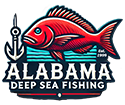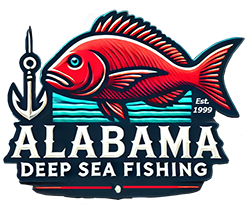Amberjack.
Amberjack has to be the hardest fighting fish you can catch on an average day trip. They average around 20-25 pounds when you get to keep one at 30 inches long, the minimum size limit. You are allowed to keep one per person per day with none allowed for the Captain or Crew. They are closed June 1 thru July 31. We catch some of these fish in the 75-80 lb. class and are known to get up to as large as 130 pounds. Most of the time you can get them in 100-150 feet of water, however I have seen them in 50 feet and especially in the late season as deep as 400 feet. You really have to bring your “A” game when fishing for these monster fish.
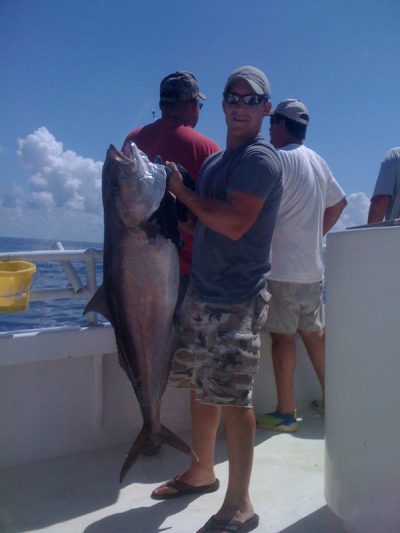
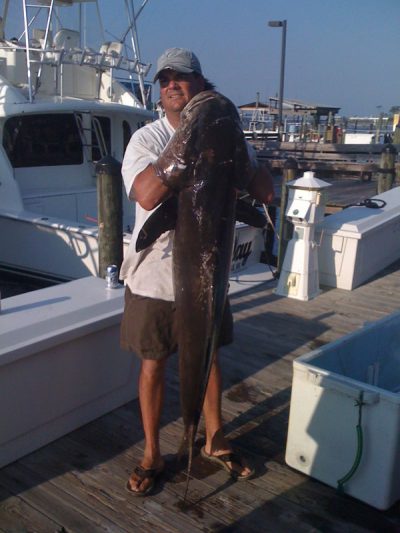
Cobia
Cobia are the easiest fish to sight fish for without having to go a hundred miles offshore to see. They migrate each year up the coast from the warmer waters that they went south to for spawning. When they come back home in the migration, they swim on top anywhere from 100 feet of the beach to several miles offshore. Of course it’s easier to see them in the shallower water when the sun is out. You typically ride into the flow of the fish at a slow pace because they will go down deep and then pop back up, usually right in front of the boat when they hear us coming. Then you throw a bait at him just in front of his line that he’s swimming far enough ahead so you don’t spook him and watch to see if he takes the bait. Usually there are several fish in a pod. Once you get the first one hooked up, you can concentrate on trying to get one of the others to bite. It can get quite exiting to say the very least! What a rush. They have been called “Brown Back”, “Crab Cruncher”, “Lemon Fish”, “ Ling”, “Eel Sucker” and other fond names. I call them “Delicious”, grilled, fried, blackened, it’s all good. If you want to get in on the “Run”, you have to be here early March and into April as they run in the spring.
Dolphin Fish
Dolphin Fish are very colorful fish that live and thrive around grass lines and patches, floating objects or on a tide line. They feed on all of the smaller fish in and around the structures in the water. At the same time they are seeking shelter under and around these things from bigger fish like Wahoo, Blue Marlin and other predators. They have a brilliant turquoise yellow and green color that looks like a neon sign when they get excited and light up. The female Dolphin will lay around 250 thousand eggs. The average size is between 35-60 inches long and can grow to around 50 pounds. They have 55-65 rays in its dorsal fin, pretty much their whole back. With a long slender body of muscle and a row of fins on top this fish can maneuver extremely well at high speeds with deadly accuracy. Talk about a fight on a fishing pole, they jump several feet in the air shaking violently time after time till they tire out. Then you can get them up to the boat safely to gaff and bring in without beating everything, including you, to death in the boat. Soon after they are put in the boat their colors begin to fade, as with all Pelagic fish, so you better have the camera ready as soon as he hits the deck. When you go to a restaurant these fish are referred to as Mahi Mahi, or Dorado. Since these are fish that stay in warm waters, they do travel all over in the Gulf Stream including the east coast and South America. One of my favorite dish is “Mahi on the Bayou.” This is a grilled or pan seared piece of Dolphin with crab meat, crawfish tails, sliced almonds and a secret Cajun cream sauce on top. I promise, this is “Fat Boy” approved – delicious!

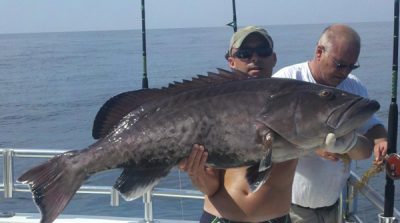
Grouper
There are several species of Grouper and they are each monitored differently. “Gag” Grouper are the most common for our area and are a very sought after fish. A common mistake people make around here is that they call a “Gag” a “Black” Grouper. The fact is that we don’t have “Black” Groupers around here, they are a South Florida or more tropical water type fish. Gag Grouper season has been lowered to only a few day due to “overfishing” they say, now we have a season starting July 1 and runs through October 31. The Nation Marine Fisheries will determine when the close date will occur and let us know. We also have Red Grouper and Scamp who fall into the “Shallow Water” Grouper category. Their season is year round till such point that “N.M.F.S.” determines otherwise. Then there are “Deep Water Grouper”, Snowy, Yellow Edge, Barrel, and Tile Fish. There are a few more and they are all delicious.
Mingo Snapper (Vermilion Snapper)
Mingo Snapper, also known as Vermilion Snapper (Rhomboplites aurorubens), is a popular deep-sea fish found in the warm waters of the Gulf of Mexico. These fish are known for their vibrant reddish-pink coloration, sleek bodies, and forked tails. They typically range from 10 to 24 inches in length and are often caught in waters 80 to 300 feet deep, congregating around reefs, wrecks, and other underwater structures.
Mingo Snapper is prized for its mild, sweet-tasting white meat, making it a favorite among anglers and seafood lovers alike. Unlike their larger cousin, the Red Snapper, Mingo Snapper is often found in schools, providing plenty of action for deep-sea fishing trips. They are usually caught using cut bait, squid, or small jigs.
If you’re looking for a fun and rewarding fishing experience, targeting Mingo Snapper is a great choice! They provide a steady bite and make for an excellent catch to take home for a delicious meal.
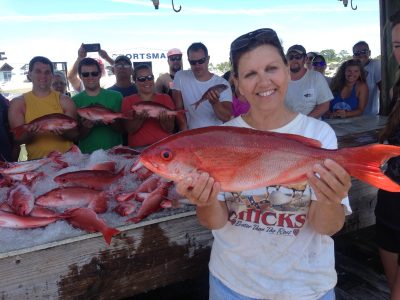
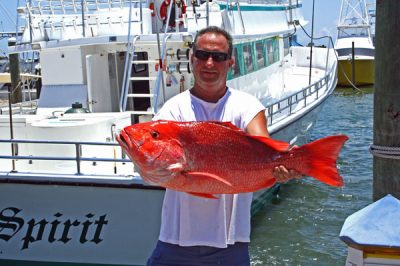
Red Snapper
Red Snapper are the most popular species we have in our area of the Gulf of Mexico. The average size is around 3-5 pounds but they do grow a whole lot bigger. A mature snapper in the 20 year old class is somewhere between 15-25 pounds. They have to be 16 inches to harvest and we are currently allowed to keep two per person not including captain or crew. The season opens on June 1 and we believe that it will be a forty day season. We will let you know when we hear anything different.
Scamp Grouper
A Coveted Catch for Gulf Anglers
Scamp Grouper (Mycteroperca phenax) is one of the most sought-after grouper species in the Gulf of Mexico, prized for both its fighting ability and its delicious, flaky white meat. Recognized by its elongated body, brownish-bronze coloration, and distinctive dark spots, Scamp is often found near reefs, rocky ledges, and underwater structures at depths ranging from 80 to 300 feet.
Anglers love targeting Scamp because of their aggressive strikes and strong runs, making them a thrilling catch on light to medium tackle. They are typically caught using live bait such as pinfish or cigar minnows, as well as jigs and cut bait.
Highly regarded as one of the best-tasting grouper species, Scamp is a fantastic choice for those looking to reel in a top-tier fish for the dinner table. Whether you’re an experienced angler or a first-time fisherman, landing a Scamp Grouper is always a rewarding experience on a deep-sea fishing adventure!
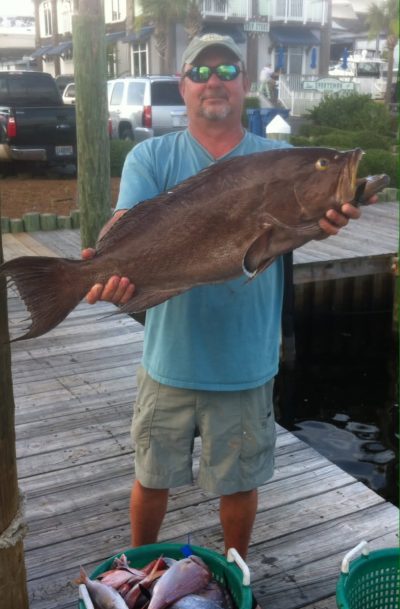
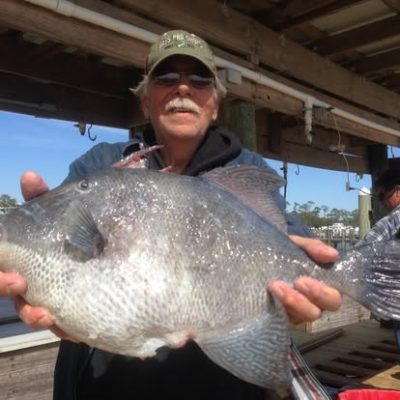
Trigger Fish
Triggerfish are one of the Best eating bottom-fish and probably the most versatile in our area. They live around wrecks and natural bottom that has some sort of shell fish or barnacles growing on it. They also eat Crabs, like a Blue Crab we have here. Their eyes are positioned far back from their mouth for moving in for the kill without getting their eyes bitten by the crabs pincers. With the big and sharp teeth they have, It’s no problem to make short business of the hard shell of it’s opponent. They also have the most unique defense mechanism which also gives it it’s name. On the top of their dorsal fin is a huge thick fin up front. When attacked by larger fish they simply lock this fin in the extended position and try as the attackers may they cannot get it to retract. When the Triggerfish is ready, he can move his smaller fins down behind the big fin (His Trigger) and it lets the locked fin back down. Cool Huh? The best thing about them is eating Triggerfish. Wow! Any way you want it! Delicious! Fried, Blackened, Baked, Broiled, Grilled, Sautéed in butter or my favorite – Boiled with crab boil and then lightly picked apart to make a West Indies Salad that will blow your socks off. You’ll never know it’s not crab meat. Triggerfish are usually suspended up in the water column or concentrated around the wreck. They are masters of stealing your bait without ever feeling a thing. With the scissor like teeth they just swim up to your bait and with the accuracy of a surgeon they slice it off. Sometimes all you feel is your line slowing down a little on the way down with your bait. By the time you get to the bottom you don’t have any left. That’s when you just drop, stop and jerk about 3-4 seconds down. Gotcha!
Wahoo
“Wahoo” is just like it sounds when they hit the line and run out about 300 yards in just a few seconds. Your heart races and you temporarily lose control of everything for a moment until you get the pole in your hand and feel the pull of a monster shaking his head back and forth and then he makes another run. Oh yea, he’s got some serious power! Most of the time, these fish live around dwellings and tide lines where bait is found and other fish like Dolphins live. They also will stay over the top of large wrecks where there is a lot of bait and will hang out in groups of several fish together. It’s not uncommon to get more that one bite off of a spot. Typically during the summer, provided we get to go over 20 miles or so, we use our High Speed trolling rods on the way out and on the way in fishing for Wahoo or King Mackerel. We catch other stuff too on the trollers like Cobia, Bonita, Shark and Blue Marlin. Just like the Dolphin, they will jump and put on a great show. I’ve seen them jump as high as 20 feet in the air. Pretty awesome! Some people like to fry Wahoo like other fish, however my favorite way is to grill a steak with some type of teriyaki glaze with lemon and garlic seasoning and a dash of some kind of Cajon seasoning. The trick is not to overcook it and dry it out. You can take the left over’s from grilling and make a mean fish salad.
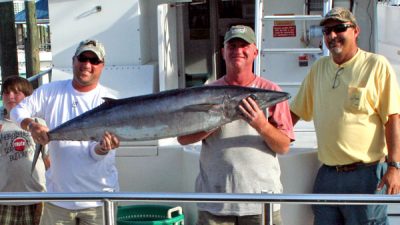

Yellowfin Tuna
Tuna come in several species. There is a Black Fin Tuna, Yellow Fin Tuna, Blue Fin Tuna and Skip Jack Tuna just to name a few. Tuna fish feed on small minnows or squid. As the size of the Tuna gets larger, so does the size of their prey. They live and thrive in the “Blue Water” normally located far offshore, although sometimes the blue water comes in with the gulf stream as close as a few miles off the beach. We fish for them around the oil rigs offshore 60-120 miles out. This is where the bait hangs out and the small fish hide from bigger fish. Depending on the location of the “Blue Water” we fish at the closest rig with the most fish. Tuna Fish are delicious Grilled or raw, a huge delicacy overseas as well as here at home.
